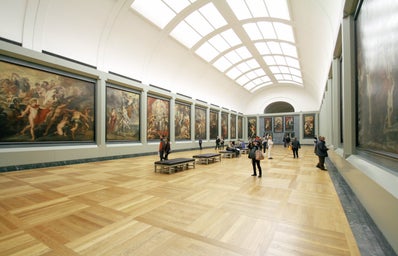The Lakeside Arts presents Sophie Ryder’s art exhibition “Sophie Ryder at The Djanogly Gallery”, featuring her imaginative sculptures, drawings, and prints of her famous works, the “Lady Hare”, and the “Minotaur”. Recorded by our Head of Reviews, Jasmine Eastman, the Her Campus team had the opportunity of interviewing Sophie to learn more about the artistic process after viewing a selection of her various works at Lakeside Arts.
WHAT IS THE SIGNIFICANCE OF USING BRONZE AND WIRE AS A MATERIAL FOR THE SCULPTURES? NATURAL MATERIALS THAT PROMISE A LACK OF COLOUR – WHAT IS THE INTENTION BEHIND THIS?
Sophie started using wire for her drawings when she was a little girl as she enjoyed the texture of it. From this point onwards, she started combining solids with the wire in her two-dimensional drawings to make them three-dimensional. At first, Sophie was opposed to using bronze, and especially painted bronze as she felt that it plasticised the art. She also said that using more than one material was commercially viable, which is why she incorporated little objects into her work. By adding a variety of different textures, her artwork became more interesting. The amazing quality of bronze itself, Sophie adds, is the reason she believes painting the sculpture with colour is unnecessary. Also, as her sculptures are often presented in an urban and natural setting, she claims that the landscape already has so much colour to offer that the sculpture doesn’t need to be painted; the neutrality against the colourful background makes it stand out. Lastly, Sophie adds that depending on where the sculpture is, the environment can change the colour of the bronze. For example, acid rain, wind, and saltwater tend to change the patina quite dramatically. Sophie tells us that she advises clients to add wax if they do not want the patina to change.
WHAT IS THE SIGNIFICANCE OF THE SMALLER OBJECTS INCORPORATED INTO THE SCULPTURES?
A unique element of Sophie’s work is her choice to include small objects. For example, she uses things like coins, toy cars, dummies, and scissors. For Sophie, this adds more texture to her art. Furthermore, she explains that she began borrowing her children’s toys, and more specifically, toys that were relevant to the year. According to Sophie, this was almost like signing a date to her artwork. As a bonus, she says that it makes it interesting for young children when viewing her exhibitions!
WHAT INSPIRED THE MINOTAUR AND THE LADY HARE?
Sophie tells us that she was very interested in Greek Mythology and Picasso at school. Picasso’s minotaur was a particular source of inspiration as his version was sexually dominant and aggressive. In contrast, Sophie decided to make her minotaur much more whimsical and caring, what she calls a gentle giant. She also gave the minotaur a companion/ counterpart in her work, the Lady Hare. For Sophie, Lady Hare is a strong character, sometimes even stronger than the Minotaur. Her earlier works of the Hare also show influences of femininity and motherhood. Although she tried a variety of different heads, she settled on using these characters because they became the way she expressed herself through her artwork. Furthermore, Sophie adds that her figures are more human than animal. She believes that by putting on the masks of the two personas, she can do things that are not possible if they were simply human. For example, the Hare and Minotaur figures are naked, as she dislikes using clothes as they are too modern and not her style. Sophie suggests that the focus, however, isn’t supposed to be on the genitalia, but on nature and the natural elements.
WHAT WAS THE IDEA BEHIND THE LADY HARE BEING SPLIT INTO THREE DIFFERENT PIECES?
In her piece “Kneeling”, Sophie presents the Hare cut up into three sections. In the initial process of creating the sculpture, she set out the different pieces of the Hare onto the grass but actually ended up liking the gaps in between them. This was particularly striking for her because she could see the sky moving through the gaps which she felt brought the piece to life in a different way. In the Yorkshire Sculpture Park, Sophie tells us that you could even walk through the gaps. However, she prefers her work inside or in an urban setting as she doesn’t create the animals to be anatomically correct but to be alive; it captures them in time.
WHAT INSPIRED TEMPLE TO 200 RABBITS?
Sophie had a distressing experience when she went to a farm where she witnessed the inhumane treatment of rabbits. In a little room, she saw some rabbits mating, some jumping around, and some deceased. She specifically recalls the distressing impression it left on her; she remembers the lack of air, the horrid smells, and the dark and dingy nature of the place. As an adult, she then went on to stay in the village of Tepostlan in Mexico when she came across a temple called ‘Temple to 200 Rabbits’. With these two memories in mind, Sophie felt inspired to create a piece of 200 rabbits that emphasised the cruelty and inhumanity she had experienced on that farm. As you walk into the little room where the piece ‘Temple to 200 Rabbits’ is presented, Sophie captures the dingy and harrowing atmosphere. As she couldn’t make the temperature of the room hot, she used sound and low lighting as another means of capturing the eery and stifling atmosphere of the rabbit farm. Sophie specifically uses the composer Morton Feldman to complement her piece. The composition continues on a loop, making it more about sound as opposed to music. This took Sophie roughly 6 months to create.
WHAT DOES SOPHIE’S ARTWORK SAY ABOUT SOCIETY?
Sophie doesn’t see herself as a political artist, instead, her work is about emotional expression. She wants to show the nicer side of humans and animals, looking at the joyful elements of the world. Sophie finds it depressing to see the cruelty of the world, and therefore art shouldn’t show just the ugly side because we already have enough of it in front of us. It should show family, bonds, and relationships. In this way, her work is seen to be happy and loving rather than political. However, she recognises how her artwork may evoke different emotions from people as they have their own unique experiences. For example, 200 Rabbits was a reaction to a horrible situation whereby she felt driven to capture the corrupt nature of animal cruelty. Soon after her work on this piece, she even became vegan. Ultimately though, she strives to make the world a happier place by focusing on the good through an artistic lens.
Hignell Gallery presents Sophie Ryder’s major solo exhibition at The Djanogly Gallery, Nottingham. Curated by Neil Walker. The exhibition will run until 12th March 2023. Make sure to visit to view the selection of smaller-scale sculptures alongside drawings and prints of her favoured subjects.


